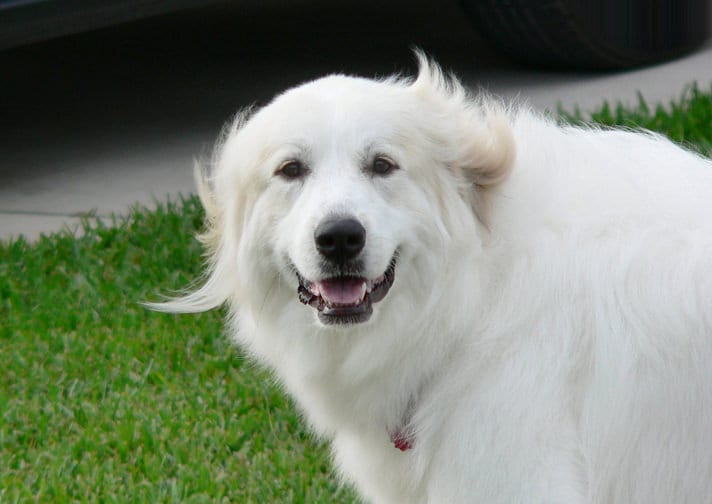Q.
How should you cut the long hair on the Great Pyrenees dog to keep it cool in this hot weather?
A.
If you adequately maintain the coat of your Great Pyrenees, you won’t need to cut its hair to keep it cool in warm weather. A double-coated breed hailing from the steep Pyrenees mountains where France borders Spain, this majestic dog has an outer coat of coarse straight or slightly wavy hair atop a dense finer undercoat, rendering it virtually weather resistant. It will “blow coat”—shed its wooly underwear—in warm weather but it will need your help in removing all that fluff. If you can manage 30 minutes once or twice a week to brush and rake your Great Pyrenees, its coat will remain tangle-free, giving it “loft” for air to circulate and keep it comfortable in all seasons.
Upkeep involves line brushing, done most effectively if you start at the same point each time, working your way around the body. Use a curved-bristle metal slicker dog brush, treating one section at a time by lifting up the hair with one hand and brushing out from the “seam” where the skin shows. Double-check your brushwork with a wide-toothed stainless steel comb or a grooming rake with teeth deep enough to penetrate to the skin.
Pay particular attention to the neck and shoulders where the hair is more profuse, forming a ruff or mane. This dog’s abundant plumed tail is another area where tangles often form. Some “Pyrs” don’t like their rear ends brushed, preferring to plunk their fannies down on the grooming table so they won’t be bothered by your efforts but this is another thick area that tangles up, along with the “pantaloons” on their back legs. Their undercarriage mats up too. In the salon, we often shave or “shell” the underbelly and inside the thighs to help the dog stay cool in warm weather.
If owners insist, we will give this dog a haircut but we would argue against shaving it down to the skin, leaving it susceptible to sunburn and in some cases, damaging hair follicles so that it does not grow back in its full abundance. We would rather give a thin and trim—or “T & T”—using a large size snap-on comb like the Andis O, A, C or E on the body and scissor-sculpting the rest of the dog’s outline so that it retains its shape and beauty. That said, we do have a couple of these gentle giants in our clientele who get clipped down short during the summer because their busy owners are unable to keep up with home care.
Principally white in color, the Great Pyrenees may also have markings of badger, gray or tan. An ancient breed favored by both peasant shepherds and ruling members of French nobility, its remains have been discovered in the fossil deposits of the Bronze Age, dating its appearance somewhere between 1800 and 1000 B.C. It is believed this giant flock guard hailed from Central Asia or Siberia, following the migration route into Europe. The height at the withers ranges from 27 inches to 32 inches for males and from 25 inches to 29 inches for females, generally weighing in between 85 and 100 pounds. Confident, loyal and affectionate in nature, it is protective of its charges—human or otherwise—when necessary.
If your taste in dogs runs to big and beautiful, don’t be put off by fear of maintenance chores. While regular brushing is required, the coat sheds dirt as you brush it so it does not need frequent bathing. Your grooming sessions will provide an opportunity to check your big friend’s ears, eyes, mouth, body, paws and skin for possible problems, which will be few if you are consistent in your care. One more note: Always check the dewclaws (single in front, double on rear paws) and keep them trimmed. Left uncut, they tend to curl around and can painfully penetrate the dog’s legs.
Posted by: Chewy Editorial
Featured Image: via Perry Correll/Shutterstock
Share:









